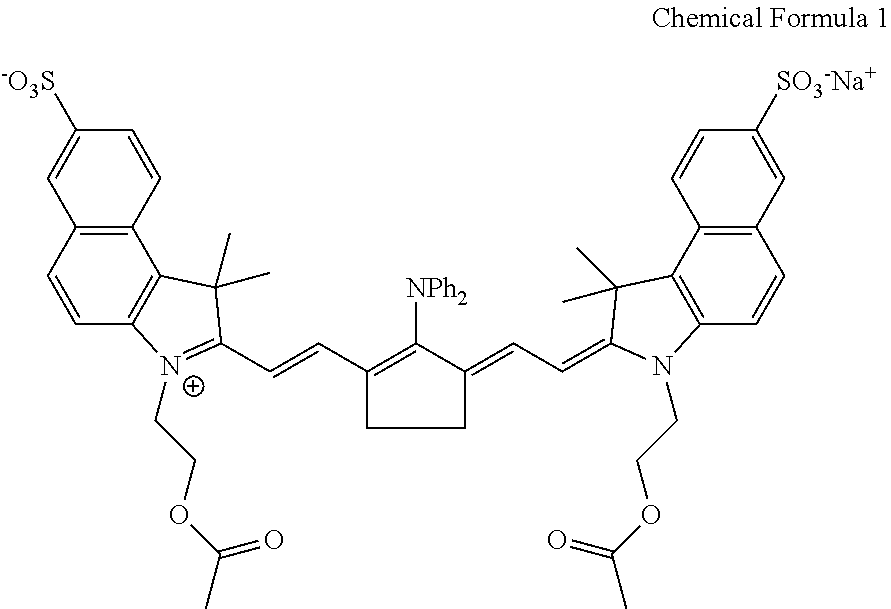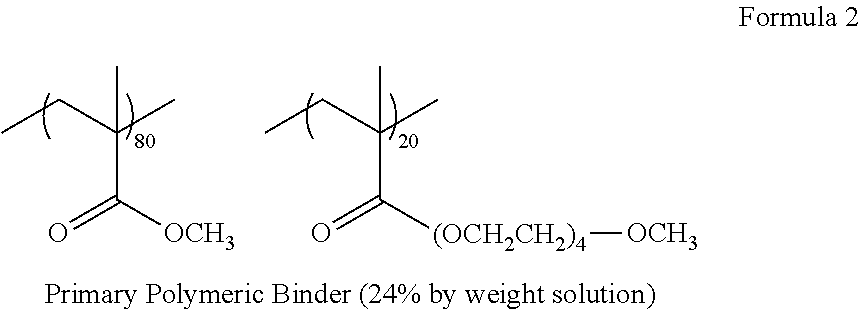Negative-working lithographic printing plate precursor and use
a lithographic printing plate and precursor technology, applied in lithography, photomechanical equipment, instruments, etc., can solve the problems of increasing the number of printing sheets before such sheets become sellable, printing failures, undesirable presence of oxygen barrier layers, etc., to improve printing durability, fast imaging speed, and fast on-press development
- Summary
- Abstract
- Description
- Claims
- Application Information
AI Technical Summary
Benefits of technology
Problems solved by technology
Method used
Image
Examples
invention example 1
[0158]To prepare negative-working lithographic printing plate precursors, a substrate with a hydrophilic surface was prepared in the following manner. The surface of an aluminum sheet was subjected to an electrolytic roughening treatment using hydrochloric acid to provide an average roughness (Ra) of 0.5 μm. The, the roughened aluminum sheet was anodized using an aqueous phosphoric acid solution to form an aluminum oxide layer of 2.5 g / m2. The aluminum sheet was then post-treated using a poly(acrylic acid) solution.
[0159]The infrared radiation-sensitive imageable layers were prepared using Formulation 1 shown in TABLE I below, which was applied onto the prepared aluminum substrate to provide a dry coverage of 1.5 g / m2 using a bar coater, followed by drying at 110° C. for 40 seconds and further cooling to 35° C. Thus, a negative-working infrared radiation-sensitive lithographic printing plate precursor was obtained.
[0160]
TABLE IComponentsAmountParticulate primary polymeric binder emu...
invention examples 2 to 15
[0162]These inventive examples were prepared as described in Invention Example 1 except that the particulate secondary resins that are shown below in TABLE II were used in place of Techpolymer SSX-105 in the infrared radiation-sensitive imageable layer and the coating weights were changed as shown in TABLE II.
[0163]
TABLE IIParticulate Secondary ResinAverageCoatingInventionParticle D2weightExampleBrand name(μm)(g / m2)2Techpolymer SSX-1055.01.03Techpolymer SSX-1055.02.04Techpolymer SSX-10888.01.55Techpolymer SSX-110910.01.56Techpolymer SSX-110910.02.57Techpolymer S SX-110910.03.58CHEMISNOW ® MX-300103.01.59CHEMISNOW ® MX-500115.01.510CHEMISNOW ® MR-7GC126.01.511TOSPEARL ® 2000B136.01.512Ganzpearl GS-0605146.51.513MIPELON ™ PM-2001510.01.514KTL-8FH163.51.515Art-pearl C-800176.01.58, 9Techpolymer SSX-108, SSX-110: Crosslinked acrylic beads (Sekisui Plastics Co., Ltd.).10-12CHEMISNOW ® MX-300, MX-500, MR-7GC: Crosslinked acrylic beads (Soken Chemical & Engineering Co., Ltd.).13TOSPEARL ® ...
invention example 16
[0164]Another negative-working infrared radiation-sensitive lithographic printing plate precursor was prepared according to the present invention in the same manner as described in Invention Example 1, except that the polymeric emulsion18 was used as the primary polymeric binder in place of the primary polymeric binder shown in TABLE I. 18Copolymer derived from PEGMA1 / acrylonitrile / styrene (24% by weight solution, average particle size D1 of 150 nm).
PUM
| Property | Measurement | Unit |
|---|---|---|
| particle size | aaaaa | aaaaa |
| particle size | aaaaa | aaaaa |
| particle size | aaaaa | aaaaa |
Abstract
Description
Claims
Application Information
 Login to View More
Login to View More - R&D
- Intellectual Property
- Life Sciences
- Materials
- Tech Scout
- Unparalleled Data Quality
- Higher Quality Content
- 60% Fewer Hallucinations
Browse by: Latest US Patents, China's latest patents, Technical Efficacy Thesaurus, Application Domain, Technology Topic, Popular Technical Reports.
© 2025 PatSnap. All rights reserved.Legal|Privacy policy|Modern Slavery Act Transparency Statement|Sitemap|About US| Contact US: help@patsnap.com



